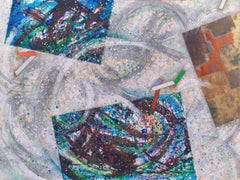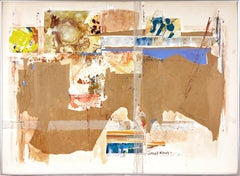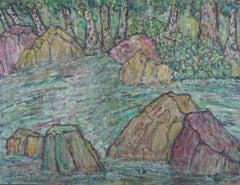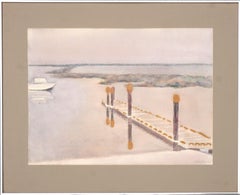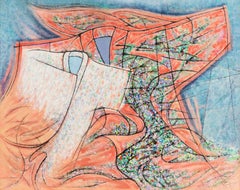Iku Nagai Art
Japanese, b. 1932
Iku Nagai first studied at the Sojusha School of Art in Tokyo, Japan and subsequently received her MFA from San Jose State University, becoming a U.S. citizen in 1958. The effect of this fusion of cultures and styles is strongly evidenced in her work by both her foreground patterning and her playfulness with spatial relationships. Arranging dynamic strokes of line, varying sizes of shapes and splashing opposite colors next to one another creates equal balance of elements in her work. The recipient of numerous prizes, medals and juried awards, Iku Nagai has exhibited both in the United States and internationally with success. Selected major group exhibitions include the Sozo Art Exhibition at the Tokyo Metropolitan Art Museum, the Triton Museum of Art and the University of California, Davis C.N. Gorman Museum among numerous others.to
1
Overall Width
to
Overall Height
to
1
1
1
1
1
1
1
1
1
10,138
2,779
1,375
1,367
1
Artist: Iku Nagai
'Large Abstract', Exhibited at Tokyo Museum Of Fine Arts, Japanese Woman Artist
By Iku Nagai
Located in Santa Cruz, CA
'Large Abstract', Exhibited at Tokyo Museum Of Fine Arts, Japanese Woman Artist
-----
Signed lower right, "Nagai" for Ikuko (Iku) K. Nagai (Japanese-American, born 1932) and painted...
Category
1980s Iku Nagai Art
Materials
Silver, Gold Leaf
Related Items
Abstract Expressionist Original Gouache on paper Collage style of de Kooning
Located in Soquel, CA
Abstract Expressionist Original Gouache on paper and Collage
Abstract Gouache and Paper Collage by Harold Winer (American, 1913-2006).
Image 30"H x 40"W
Slat with white paint .25" ...
Category
1980s Post-War Iku Nagai Art
Materials
Gouache, Illustration Board, Laid Paper
$1,680 Sale Price
20% Off
H 30 in W 40 in D 0.25 in
Mid Century Mountain Stream Modernist Landscape
By Honora Berg
Located in Soquel, CA
Mid Century Mountain Stream Modernist Landscape by Honora Berg
This mid century modernist landscape painting by Honora Berg (American, 1897-1985) depicts a vibrant mountain stream, ...
Category
1950s Modern Iku Nagai Art
Materials
Gouache, Laid Paper
Blue, Pink & Red Abstract in Watercolor on Paper
By Les Anderson
Located in Soquel, CA
Blue, Pink & Red Abstract in Watercolor on Paper
A bold abstract expressionist watercolor by Les (Leslie Luverne) Anderson (American, 1928-2009). Bright sections of yellow, pink, orange, and red are divided by dark blue lines. Although some shapes are repeated, there is not a definitive pattern, which creates a dynamic composition.
Signed "Les Anderson" on verso. From the estate of Les Anderson in Monterey, California.
Unframed.
Paper size: 14"H x 20"W.
Les (Leslie Luverne) Anderson(American, 1928-2009) owned and operated the Bear Flag Gallery in San Juan Bautista...
Category
1980s Abstract Impressionist Iku Nagai Art
Materials
Watercolor, Laid Paper
$348 Sale Price
20% Off
H 14 in W 20 in D 0.03 in
Yellow, Purple & Red Abstract
By Les Anderson
Located in Soquel, CA
A bold abstract expressionist watercolor with yellow and purple, contrasted with dynamic red linear accents, by Les (Leslie Luverne) Anderson (American, 1928-2009). Signed "Les Ander...
Category
1980s Post-Impressionist Iku Nagai Art
Materials
Watercolor, Laid Paper
Abstract Expressionist Original Watercolor on Paper style of de Kooning
Located in Soquel, CA
Abstract Expressionist Original Watercolor on Paper style of de Kooning
Abstract Watercolor titled "Lands End" by Harold Winer (American, 1913-2006). Bright and bold colors of a Fl...
Category
1970s Post-War Iku Nagai Art
Materials
Illustration Board, Laid Paper, Watercolor
$1,550
H 25.25 in W 34.75 in D 0.25 in
Large Scale Arts & Craft Style Vertical Triptych
By Patricia A. Pearce
Located in Soquel, CA
Unusual and stunning vertical collotype and hand-painted triptych (3 panels) abstract composition titled "Mutable Green" of subtle gold and silver gilding evoking Frank Loyd Wright b...
Category
Late 20th Century Abstract Geometric Iku Nagai Art
Materials
Silver, Gold Leaf
$1,720 Sale Price
20% Off
H 88.5 in W 42.5 in D 0.01 in
Space Bound, Large-Scale Gouache & Mixed Media Abstract
By Nancy Louise Jones
Located in Soquel, CA
Large-scale mixed media and gouache abstract by Nancy Louise Jones (American, 20th century), 1980. This large-scale abstract piece features a cool color palette with layered geometric shapes and planes, evocative of outer space and the cosmos.
Signed and dated "1980" on the bottom right.
Presented in a metal frame.
Image size, 39"H x 48"L.
About the Artist:
Mentors: William Brice, Ron Pekar, Manfred Mueller, Gere Kavanaugh.
Permanent Museum Collections: Huntington Library Archive, “Intimate View of LA”, San Marino, CA
South Bay Contemporary Museum, Torrance, CA
Published Work:
2012 “Nymphas Dissolutio”, The Bride Revisited Mercedes Gertz/ Nancy Louise Jones
2010 Billy IDOL...
Category
1980s Minimalist Iku Nagai Art
Materials
Gouache, Mixed Media, Laid Paper
$2,850
H 47 in W 56 in D 2 in
Patricia Fabricant, 051720, 2020, Gouache On Paper, 12 x 9 inches, Color, Optics
By Patricia Fabricant
Located in Darien, CT
Throughout her career as a painter Patty Fabricant has pivoted back and forth between figurative and abstract work. Each time she makes the switch it feels abrupt, and yet increasing...
Category
2010s Abstract Geometric Iku Nagai Art
Materials
Gouache, Laid Paper
Landscape
By Wes Olmsted
Located in Buffalo, NY
An original watercolor painting by Westley "Wes" Olmsted. This work is currently featured in the exhibition Man of Extremes at Benjaman Gallery in Buffalo, NY.
Westley G. Olmsted ...
Category
1970s Modern Iku Nagai Art
Materials
Gold Leaf
Green and Blue Feathers Abstract
Located in Soquel, CA
Dramatic abstract expressionist landscape with vibrant hues of green and blue like feathers by unknown artist Gottlieb (American,20th Century) c.1965. S...
Category
1960s Abstract Expressionist Iku Nagai Art
Materials
Watercolor, Laid Paper
Athirst V
Located in New Orleans, LA
Ina Kaur (b. 1980) is a multidisciplinary artist whose conceptually driven work responds to imbalances and injustices within social, cultural, and ecological environments. Her practi...
Category
21st Century and Contemporary Contemporary Iku Nagai Art
Materials
Gold Leaf
"Ring Three" Abstracted Caryatid Figurative
By Doris Warner
Located in Soquel, CA
Gorgeous abstracted figurative of Caryatids titled "Ring Three" by Doris Ann Warner (American, 1925-2010). Signed, titled, and dated "Warner 1970" on verso. Displayed in rustic wood ...
Category
1960s Abstract Iku Nagai Art
Materials
Watercolor, Laid Paper
Previously Available Items
Boat at the Dock, Alviso Bay Area Tonalist Landscape Watercolor by Iku Nagai
By Iku Nagai
Located in Soquel, CA
Boat at the Dock, Alviso Bay Area Tonalist Landscape Watercolor by Iku Nagai
Lovely Tonalist watercolor landscape of Alviso, California by Iku K. Nagai (Japanese/American, b. 1932)....
Category
1980s Tonalist Iku Nagai Art
Materials
Watercolor, Laid Paper
H 24 in W 29.25 in D 1 in
'Mother and Child', Large, Tokyo Museum Exhibition Work, Japanese Woman Artist
By Iku Nagai
Located in Santa Cruz, CA
Signed lower right, "Nagai" for Iku K. Nagai (Japanese-American, 20th century) and painted circa 1960.
Iku Nagai first studied at the Sojusha School of Art in Tokyo, Japan and subs...
Category
1960s Abstract Iku Nagai Art
Materials
Canvas, Mixed Media
Iku Nagai art for sale on 1stDibs.
Find a wide variety of authentic Iku Nagai art available for sale on 1stDibs. You can also browse by medium to find art by Iku Nagai in laid paper, paint, paper and more. Much of the original work by this artist or collective was created during the 20th century and is mostly associated with the abstract style. Not every interior allows for large Iku Nagai art, so small editions measuring 30 inches across are available. Customers who are interested in this artist might also find the work of Tetsuro Shimizu, Tomo Mori, and Fusako Ekuni. Iku Nagai art prices can differ depending upon medium, time period and other attributes. On 1stDibs, the price for these items starts at $920 and tops out at $6,500, while the average work can sell for $3,710.
